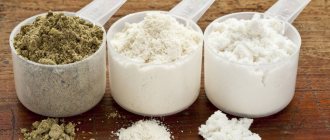ALANIN
Properties:
- nonessential amino acid
- an important source of energy for the brain and central nervous system
- strengthens the immune system by producing antibodies
- actively participates in the metabolism of sugars and organic acids, an important source of energy and a regulator of blood sugar levels.
Signs of excess alanine:
- a feeling of fatigue that does not go away after 12 hours of rest
- decreased memory and ability to concentrate
- sleep problems
- depression
- muscle pain
- joint pain
Signs of alanine deficiency:
- increased fatigue, nervousness and depression
- hypoglycemia (low blood sugar)
- urolithiasis disease
- reduced immunity, frequent viral diseases
- decreased libido
- decreased appetite
ARGININE
Properties:
- conditionally essential amino acid, after 30 years synthesis decreases
- normalizes metabolic processes in the body (reduces cholesterol)
- reduces intraocular pressure
- participates in the production of hormones and enzymes
- increases muscle mass, at the same time reduces the content of fatty tissue in the body, strengthens the framework of muscles and cartilage
- supports normal functioning of the nervous and immune systems
- improves sperm composition in men
- increases blood flow to the genitals in men and women, increases potency and libido, enhances sexual desire
- participates in the production of the hormone serotonin (the hormone of joy)
Signs of excess arginine:
- hives
- limb tremors
- irritability turning into aggressiveness
- lowering blood pressure
Signs of arginine deficiency:
- increased blood pressure
- brain disorder
- hormonal imbalances
- deterioration of sperm condition
- decreased libido
- premature aging
- obesity
ASPARAGIC ACID
Properties:
- nonessential amino acid
- strengthens the body and increases performance
- participates in the synthesis of immunoglobulins
- plays a vital role in metabolism
- speeds up recovery from fatigue
- Helps extract energy from complex carbohydrates
- deactivation of ammonia, helps the liver remove residual elements of chemicals and drugs from the body
- participates in the production of urea in the human body (binds ammonia and transfers it to the kidneys for subsequent excretion)
- helps potassium and magnesium ions penetrate into the cell
- increases testosterone production in the body and its release by the testicles
Signs of excess aspartic acid:
- overexcitation of the nervous system
- increased aggressiveness
- blood thickening
- increase testosterone, prolactin, growth hormone
- For pregnant women, consuming large amounts of foods containing aspartic acid can negatively affect the baby's nervous system, causing autism.
Signs of aspartic acid deficiency:
- memory impairment
- depression
- decreased performance
- decreased levels of testosterone, progesterone
- decreased libido
- decreased immunity
Amino acids in food
Amino acids can enter our body both from animal products and from plant foods. However, not all foods are equal in amino acid composition.
It is known that protein products of animal origin contain a set of all essential amino acids. These are products such as:
- Meat – beef, veal, pork, lamb, poultry
- Fish and seafood – all types of fish, caviar, shrimp, etc.
- Eggs – chicken, quail
- Fermented milk products - milk, kefir, fermented baked milk, yogurt, sourdough, cottage cheese, hard and soft cheeses
Plant foods do not contain all types of essential amino acids. Proponents of vegetarianism argue that this lack of plant protein can be solved. To do this, you need to diversify the types of plant foods as much as possible.
This may be suitable for people leading a normal lifestyle, but for bodybuilding this recommendation is unacceptable. In this case, you will have to consume a huge amount of plant food.
Moreover! Even when eating a normal list of foods containing animal protein, there is a high probability that you will not receive the required amount of essential amino acids.
Therefore, in bodybuilding, it is very often practiced to take amino acids in the form of various sports supplements.
GLYCINE
Properties:
- nonessential amino acid
- metabolic regulator
- normalizes the processes of excitation and inhibition in the central nervous system
- has an anti-stress effect
- increases mental performance.
Signs of excess glycine:
- hyperactivity
- rapid heartbeat
- various allergic reactions
- facial redness
- fatigue
Signs of glycine deficiency:
- increased nervous excitability
- bad dream
- trembling in the body
- weakness
- depression
Replaceable and essential amino acids
The source of amino acids in food products is proteins. All food proteins differ in their amino acid composition. This is of great importance in the selection of complete diets due to the fact that a number of amino acids are irreplaceable (essential) - they can only be obtained from food products. Essential proteinogenic amino acids include valine, isoleucine, leucine, threonine, methionine, lysine, phenylalanine, tryptophan. In contrast, nonessential amino acids can be synthesized in the human body from precursors. These are glycine, alanine, proline, serine, cysteine, aspartate, asparagine, glutamate, glutamine, tyrosine. Partially replaceable ones include arginine and histidine, since they are synthesized rather slowly in the body.
A deficiency or complete absence of even one essential amino acid in the diet leads to a negative nitrogen balance, which in turn over time causes severe clinical consequences such as vitamin deficiency: disruption of the central nervous system, growth arrest, etc.
It is extremely important to note that if any one essential amino acid is deficient, this leads to incomplete absorption of others. This pattern is subject to Liebig’s law, according to which the development of living organisms is determined by the essential substance that is present in the smallest quantity.
What foods contain essential amino acids? These are all food ingredients rich in protein.
GLUTAMIC ACID
Properties:
- conditionally essential amino acid, is a neurotransmitter transmitting impulses in the central nervous system
- participates in protein and carbon metabolism
- increases the body's resistance to hypoxia (oxygen starvation)
- neutralizes ammonia
- participates in the synthesis of nucleic acids
- glutamic acid can be converted into some essential amino acids, in particular histidine and arginine
- maintains natural hair color, elasticity and smoothness of the skin
Signs of excess glutamic acid:
- blood thickening
- headache
- decreased hemoglobin levels
- nausea
- liver dysfunction
- Alzheimer's disease
- decreased vision and glaucoma
- liver and kidney diseases
Signs of glutamic acid deficiency:
- disruption of the gastrointestinal tract
- early gray hair (before 30 years);
- problems with the central and autonomic nervous system
- skin aging
- memory loss, depressed mood
- weak immunity
- epileptic seizures
Essential amino acids for humans: list
The myth that it is impossible to obtain essential amino acids from plant foods does not stand up to criticism. This myth can be blown to smithereens by a simple argument: there are thousands and hundreds of thousands of living creatures in the world who have never consumed a single gram of meat food in their lives - where do they get essential amino acids from? And if we assume that, for example, chicken meat contains these essential amino acids, then the question arises, where does the poor chicken get them from? Does he really eat meat on the sly?
Any schoolchild knows that chicken eats plant foods. Two possible conclusions can be drawn from this, each of which destroys the myth about the need to consume meat as a source of essential amino acids.
- Chicken gets essential amino acids from plant foods. This means that the same thing is available to humans.
- Chicken does not get essential amino acids from plant foods. This means that its meat does not contain them and meat cannot be a source of essential amino acids.
The most likely and logical is the first option, since in nature everything is thought out and harmonious, and even without a complete list of amino acids, herbivores would not be able to live fully. Therefore, it is clear that all essential amino acids can be obtained from plant foods.
Why, in fact, are amino acids called “essential”? The fact is that of the 20 amino acids that are involved in protein synthesis, the body is capable of producing eleven itself, and nine must be received from the outside. There are different opinions regarding essential amino acids. Some sources say there are eight, others insist there are nine. Why are there such disagreements and how many are there really? The fact is that there are only eight truly essential amino acids, and the ninth - histidine - is indispensable only for the child’s body, and is perfectly synthesized independently in an adult. An essential amino acid for children is arginine, which is also synthesized in the adult body. Therefore, the answer to the question “how many essential amino acids are there for an adult?” obvious: there are eight of them.
So, there are 8 essential amino acids that the body cannot synthesize itself:
- valine;
- isoleucine;
- leucine;
- lysine;
- methionine;
- threonine;
- tryptophan;
- phenylalanine.
VALINE
Properties:
- essential amino acid
- participates in the formation and restoration of muscle tissue
- is part of the elastin of all connective tissues of the human body
- normalizes nitrogen balance in the body
- participates in the synthesis of glial cells that protect nerve fibers
- improves the body's adaptation to cold and heat
- the main substance needed by the body for the biosynthesis of vitamin B5
- dulls the feeling of hunger
- promotes the synthesis of serotonin (the hormone of joy)
- improves coordination
Signs of excess valine:
- crawling sensations, numbness, tingling in the limbs
- problems with the gastrointestinal tract
- irritability
- allergic reactions.
Signs of valine deficiency:
- cracks in the mucous membranes
- arthritis and arthrosis
- memory impairment
- weakened immune system
- depressed mood
- light sleep
- muscular dystrophy (muscles become flabby, any tension causes pain)
- dry mucous membranes of the eyes
- temperature changes in the external environment cause a feeling of chills or heat (“I’m cold”, “I’m hot”)
Food as sources of essential amino acids
Amino acids are extremely rarely presented in free form. The latter is found in special food products, for example, sports nutrition, where they are directly added in a free state for faster and more complete absorption. Basically, they enter the body as part of proteins and are then released during the hydrolysis of the latter. Amino acids or small peptides released as a result of hydrolysis can already be absorbed in the intestine.
The most important sources of essential amino acids in the required ratio are the following food products, which contain easily digestible proteins: milk, dairy products, eggs, meat and meat products, fish, seafood, soybeans, legumes (peas, lentils, beans, soybeans), cereals, bread, potatoes, etc.
Along with the amino acid composition, the biological value of proteins is determined by the degree of their absorption after digestion.
The degree of digestion, in turn, depends, on the one hand, on the state of the body (enzyme activity, depth of hydrolysis in the gastrointestinal tract), and on the other hand, on the type of pre-treatment of proteins in food preparation processes (thermal, hydrothermal, microwave and etc.). Heat treatment, boiling, mashing and grinding speed up the digestion of protein, especially vegetable protein, while heating to very high temperatures above 100°C makes it difficult. Back to Product Composition
METHIONINE
Properties:
- essential amino acid,
- detoxification of the body from heavy metals
- protecting the body from radiation
- protects against atherosclerosis
- protects the liver from excess fat
- activates hormones, vitamins and enzymes that have the property of neutralizing various toxins
Signs of excess methionine:
- allergic reactions;
- nausea and vomiting;
- feeling drowsy
Pregnant women, nursing mothers and women should not take methionine without consulting a doctor because methionine increases estrogen production.
Signs of methionine deficiency:
- liver damage
- swelling
- hair fragility
- slow development of the fetus and newborn
- malformations of the nervous system in children
- severe mental disorders
- development of atherosclerosis
ORNITINE
Properties:
- a nonessential amino acid that is present and synthesized in the human body
- ornithine has the property of being converted to arginine
- stimulates the secretion of growth hormone
- stimulates insulin synthesis
- protects the liver from the toxic effects of various foods and pharmacological drugs, restores liver cells
- removes ammonia from the body
- improves the functioning of the immune system
- promotes rapid healing of wounds
Signs of deficiency and excess of amino acids in the body
An excess of amino acids in the human body is a rather rare phenomenon. Symptoms indicating excessive amino acid intake include:
- Strong and pungent odor from the mouth
- Heaviness in the stomach
- General lethargy and decreased performance
- Discomfort in the kidney area
- Increased thirst
Note! These are all indirect signs! Which cannot in any way be the reason for making a diagnosis. An excess of amino acids in the body can only be accurately determined by taking a protein test in the laboratory.
Symptoms characteristic of a lack of amino acids in the body:
- Sudden weight loss due to muscles - muscular dystrophy
- Decreased immunity
- Deterioration and prolongation of wound healing time
- Bad feeling
- Low performance
- Sudden, unreasonable mood swings are possible
- Increased brittleness of nails and hair
Again, this is not a description of the diagnosis! But only a list of indirect signs! If you suspect a lack of amino acids, be sure to go to the laboratory and get tested for protein!
PHENYLALANINE
Properties:
- essential amino acid
- in the body it can be converted into tyrosine, which, in turn, is used in the synthesis of two main neurotransmitters: dopamine and norepinephrine
- affects mood, reduces pain, improves memory and learning ability
- suppresses appetite.
Signs of excess phenylalanine:
- overexcitation of the nervous system
- memory loss
- disruption of the entire nervous system.
Signs of phenylalanine deficiency:
- memory loss
- Parkinson's disease
- depressive state
- chronic pain
- loss of muscle mass and sudden weight loss
- hair bleaching
- premenstrual syndrome
Where are essential amino acids found?
As mentioned above, the myth about the presence of essential amino acids only in animal foods is precisely a myth actively promoted by food corporations and the owners of the meat processing industry. And this myth, unfortunately, has replaced the debunked and defeated myth about the need for a foreign protein to build human cells. However, he too was already reeling. You can find plenty of information on the Internet about which plant foods contain all eight essential amino acids.
- First of all, legumes are rich in essential amino acids - peas, lentils, chickpeas, peanuts, etc. However, it is worth noting that peanuts are extremely undesirable for consumption. In order to protect the plant and fruits from being eaten by pests during the growing process, peanuts are crossed with petunia genes, and such peanuts are extremely harmful to the liver. And according to statistics, there are more than 90% of such genetically modified peanuts on the market in the CIS countries. However, even if peanuts are not modified, under improper storage conditions very dangerous mold will form on them, which leads to cancer. Peanuts also acidify our body, which is extremely harmful.
- Nuts, seeds and grains are rich in amino acids. Sunflower seeds, pumpkin seeds and sesame seeds will be especially useful. And among the cereals - oats and unpolished (this is important!) rice. Among the nuts, almonds, cashews and walnuts contain the most amino acids.
Thus, a complete list of essential amino acids can be obtained even if all animal products are excluded from the diet. The myth of essential amino acid deficiency in vegetarian and vegan diets is nothing more than a “bogeyman” for those who decide to switch to healthy, ethical nutrition. The meat industry cannot afford a mass exodus of its consumers, so it invents more and more myths to force people to consume products that are harmful to health and the environment, from which interested sellers make huge money.
TYROSINE
Properties:
- conditionally essential amino acid, is a precursor to the neurotransmitters norepinephrine and dopamine
- participates in mood regulation; a lack of tyrosine leads to a deficiency of norepinephrine, which leads to depression
- suppresses appetite
- reduces fat deposits
- promotes the production of melatonin and improves the functions of the adrenal glands, thyroid gland and pituitary gland
- participates in phenylalanine metabolism
- Thyroid hormones are formed by the addition of iodine atoms to tyrosine
Signs of excess tyrosine:
- loss of muscle mass
- manifestation of hypertension
- decreased body temperature
- increased heart rate
Signs of tyrosine deficiency:
- obesity
- fast fatiguability
- state of depression
- poor stress resistance
- sudden mood swings
- premenstrual pain
- loss of appetite
- decreased brain activity
- manifestations of Parkinson's disease
- dysfunction of the thyroid gland
- hyperreactivity
- disorders of the adrenal glands
Conditionally essential amino acids
In addition to essential amino acids, there are also conditionally essential amino acids.
. This is a group of substances that can be produced by our body independently, but only if a certain amount comes from food.
Conditionally indispensable include:
- Arginine, involved in cleansing the liver and regulating muscle growth;
- Histidine, which affects the production of white and red blood cells, as well as muscle growth;
- Cystine, which is part of connective tissue;
- Tyrosine, which partially replaces phenylalanine in protein synthesis, and prevents stress.
LEUCINE / ISOLEUCINE
Properties:
- energy source
- participates in hemoglobin biosynthesis
- regulates blood sugar levels and stimulates growth hormone
- participates in the utilization of cholesterol
- reduces recovery time for tired muscles
- the valine-isoleucine pair suppresses the production of cortisol
Signs of excess isoleucine:
- blood thickening
- increased concentration of ammonia and free radicals in the body
- apathy
- allergic reactions
People suffering from kidney and liver diseases should not get carried away with supplements containing this amino acid!









